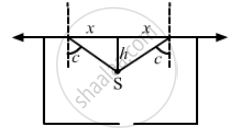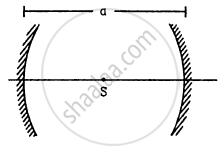Advertisements
Advertisements
प्रश्न
A point source is placed at a depth h below the surface of water (refractive index = μ). (a) Show that light escapes through a circular area on the water surface with its centre directly above the point source. (b) Find the angle subtended by a radius of the area on the source.
उत्तर
Given,
Refractive index is μ
(a)
Let the point source be P, which is placed at a depth of h from the surface of water.
Let us take x as the radius of the circular area.
and let θc be the critical angle.
Thus,
\[\frac{x}{h} = \tan \theta_c \]
\[\frac{x}{h} = \frac{\sin \theta_c}{\sqrt{1 - \sin^2 \theta_c}}\]
\[ = \frac{\frac{1}{\mu}}{\sqrt{1 - \frac{1}{\mu^2}}} \left( \because \sin \theta_c = \frac{1}{\mu} \right)\]
\[\frac{x}{h} = \frac{1}{\sqrt{\mu^2 - 1}}\]
\[x = \frac{h}{\sqrt{\mu^2 - 1}}\]
Clearly from figure, the light escapes through a circular area at a fixed distance r on the water surface, directly above the point source.
That makes a circle, the centre of which is just above P.
(b)
The angle subtended by the radius of the circular area on the point source P:
\[\Rightarrow \sin \theta_c = \frac{1}{\mu}\]
\[\Rightarrow \theta_c = \sin^{- 1} \left( \frac{1}{\mu} \right)\]
APPEARS IN
संबंधित प्रश्न
Show with the help of a diagram, how unpolarised light from Sun gets linearly polarised by scattering.
Write two points of difference between the phenomena of interference and diffraction.
Why does the Sun look reddish at sunset or sunrise ?
Describe briefly using a diagram how sunlight is polarised ?
A parallel beam of light is incident on a converging lens parallel to its principal axis. As one moves away from the lens on the other side on its principal axis, the intensity of light
A thin lens is made with a material having refractive index
\[\mu = 1 \cdot 5\]. Both the side are convex. It is dipped in water \[\mu = 1 \cdot 33\]. It will behave like
A concave mirror having a radius of curvature 40 cm is placed in front of an illuminated point source at a distance of 30 cm from it. Find the location of the image.
A candle flame 1.6 cm high is imaged in a ball bearing of diameter 0.4 cm. If the ball bearing is 20 cm away from the flame, find the location and the height of the image.
A point source S is placed midway between two converging mirrors having equal focal length f as shown in figure. Find the values of d for which only one image is formed.
k transparent slabs are arranged one over another. The refractive indices of the slabs are μ1, μ2, μ3, ... μk and the thicknesses are t1 t2, t3, ... tk. An object is seen through this combination with nearly perpendicular light. Find the equivalent refractive index of the system which will allow the image to be formed at the same place.
A biconvex thick lens is constructed with glass (μ = 1.50). Each of the surfaces has a radius of 10 cm and the thickness at the middle is 5 cm. Locate the image of an object placed far away from the lens.
Fill in the blank and rewrite the completed statement:
Very fine particles mainly scatter ______ light.
Answer the following question in detail.
State the conditions under which a rainbow can be seen.
Answer the following question in detail.
Explain the formation of a primary rainbow. For which angular range with the horizontal is it visible?
Answer the following question in detail.
Is it possible to see primary and secondary rainbow simultaneously? Under what conditions?
A plano-convex lens is made of material having refractive index 1.5. The radius of curvature of curved surface is 40 cm. The focal length of the lens is ____________ cm.
Explain the formation of primary and secondary rainbow.
A parallel beam of light of wavelength 5890 Å falls normally on a slit of width 0.2 mm. Find the distance between the first minima on the two sides of the central maximum of the diffraction pattern observed on a screen placed in the focal plane of a convex lens of focal length 50 cm. The lens is placed quite close to the slit.
Between the primary and secondary rainbows, there is a dark band known as Alexandar’s dark band. This is because ______.
- light scattered into this region interfere destructively.
- there is no light scattered into this region.
- light is absorbed in this region.
- angle made at the eye by the scattered rays with respect to the incident light of the sun lies between approximately 42° and 50°.
